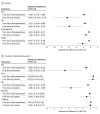Use of Machine Learning to Assess the Management of Uncomplicated Urinary Tract Infection
- PMID: 39888618
- PMCID: PMC11786233
- DOI: 10.1001/jamanetworkopen.2024.56950
Use of Machine Learning to Assess the Management of Uncomplicated Urinary Tract Infection
Abstract
Importance: Uncomplicated urinary tract infection (UTI) is a common indication for outpatient antimicrobial therapy. National guidelines for the management of uncomplicated UTI were published in 2011, but the extent to which they align with current practices, patient diversity, and pathogen biology, all of which have evolved greatly in the time since their publication, is not fully known.
Objective: To reevaluate the effectiveness and adverse event profile for first-line antibiotics, fluoroquinolones, and oral β-lactams for treating uncomplicated UTI in contemporary clinical practice.
Design, setting, and participants: This retrospective, population-based cohort study used a claims dataset from Independence Blue Cross, which contains inpatient, outpatient, laboratory, and pharmacy claims that occurred between 2012 and 2021, formatted into the Observational Medical Outcomes Partnership (OMOP) common data model. Participants were nonpregnant female individuals aged 18 years or older with a diagnosis of uncomplicated, nonrecurrent UTI at an outpatient setting. Patients must also have been treated with first-line (nitrofurantoin or trimethoprim-sulfamethoxazole), fluoroquinolone (ciprofloxacin, levofloxacin, or ofloxacin), or oral β-lactam (amoxicillin-clavulanate, cefadroxil, or cefpodoxime) antibiotics. Data analysis was performed from November 2021 to August 2024.
Exposures: Patients exposed to first-line antibiotics were assigned to the treatment group, and those exposed to fluoroquinolone or β-lactam treatments were assigned to control groups.
Main outcomes and measures: The primary outcome was a composite end point for treatment failure, defined as outpatient or inpatient revisit within 30 days for UTI, pyelonephritis, or sepsis. Secondary outcomes were the risk of 4 common antibiotic-associated adverse events: gastrointestinal symptoms, rash, kidney injury, and Clostridium difficile infection.
Results: There were 57 585 episodes of UTI among 49 037 female patients (mean [SD] age, 51.7 [20.1]) years), with prescriptions for first-line antibiotics in 35 018 episodes (61%), fluoroquinolones in 21 140 episodes (37%), and β-lactams in 1427 episodes (2%). After adjustment, receipt of first-line therapies was associated with an absolute risk difference of -1.78% (95% CI, -2.37% to -1.06%) for having a revisit for UTI within 30 days of diagnosis vs fluoroquinolones. First-line therapies were associated with an absolute risk difference of -6.40% (95% CI, -10.14% to -3.24%) for 30-day revisit compared with β-lactam antibiotics. Differences in adverse events were similar between all comparators. Results were identical for models built with an automated OMOP feature extraction package.
Conclusions and relevance: In this cohort study of patients with uncomplicated UTI derived from a large regional claims dataset, national treatment guidelines published almost 14 years ago continue to recommend optimal treatments. These results also provide proof-of-principle that automated feature extraction methods for OMOP formatted data can emulate manually curated models, thereby promoting reproducibility and generalizability.
Conflict of interest statement
Figures



Update of
-
Reassessing the management of uncomplicated urinary tract infection: A retrospective analysis using machine learning causal inference.medRxiv [Preprint]. 2024 Aug 19:2024.08.18.24312104. doi: 10.1101/2024.08.18.24312104. medRxiv. 2024. Update in: JAMA Netw Open. 2025 Jan 02;8(1):e2456950. doi: 10.1001/jamanetworkopen.2024.56950. PMID: 39228716 Free PMC article. Updated. Preprint.
Similar articles
-
Non-steroidal anti-inflammatory drugs for treating symptomatic uncomplicated urinary tract infections in non-pregnant adult women.Cochrane Database Syst Rev. 2024 Dec 19;12(12):CD014762. doi: 10.1002/14651858.CD014762.pub2. Cochrane Database Syst Rev. 2024. PMID: 39698942
-
Reassessing the management of uncomplicated urinary tract infection: A retrospective analysis using machine learning causal inference.medRxiv [Preprint]. 2024 Aug 19:2024.08.18.24312104. doi: 10.1101/2024.08.18.24312104. medRxiv. 2024. Update in: JAMA Netw Open. 2025 Jan 02;8(1):e2456950. doi: 10.1001/jamanetworkopen.2024.56950. PMID: 39228716 Free PMC article. Updated. Preprint.
-
Sexual Harassment and Prevention Training.2024 Mar 29. In: StatPearls [Internet]. Treasure Island (FL): StatPearls Publishing; 2025 Jan–. 2024 Mar 29. In: StatPearls [Internet]. Treasure Island (FL): StatPearls Publishing; 2025 Jan–. PMID: 36508513 Free Books & Documents.
-
[National S3 guideline on uncomplicated urinary tract infection: recommendations for treatment and management of uncomplicated community-acquired bacterial urinary tract infections in adult patients].Urologe A. 2011 Feb;50(2):153-69. doi: 10.1007/s00120-011-2512-z. Urologe A. 2011. PMID: 21312083 German.
-
Head-to-head trials of antibiotics for bronchiectasis.Cochrane Database Syst Rev. 2018 Sep 5;9(9):CD012590. doi: 10.1002/14651858.CD012590.pub2. Cochrane Database Syst Rev. 2018. PMID: 30184243 Free PMC article.
Cited by
-
Evaluation of Machine Learning-Based Propensity Score Estimation: A Benchmarking Observational Analysis Against a Randomized Trial.medRxiv [Preprint]. 2025 Jun 17:2025.06.16.25329708. doi: 10.1101/2025.06.16.25329708. medRxiv. 2025. PMID: 40585154 Free PMC article. Preprint.
References
-
- Gupta K, Hooton TM, Naber KG, et al. . International clinical practice guidelines for the treatment of acute uncomplicated cystitis and pyelonephritis in women: a 2010 update by the Infectious Diseases Society of America and the European Society for Microbiology and Infectious Diseases. Clin Infect Dis. 2011;52(5):e103-e120. doi:10.1093/cid/ciq257 - DOI - PubMed
Publication types
MeSH terms
Substances
Grants and funding
LinkOut - more resources
Full Text Sources
Medical

